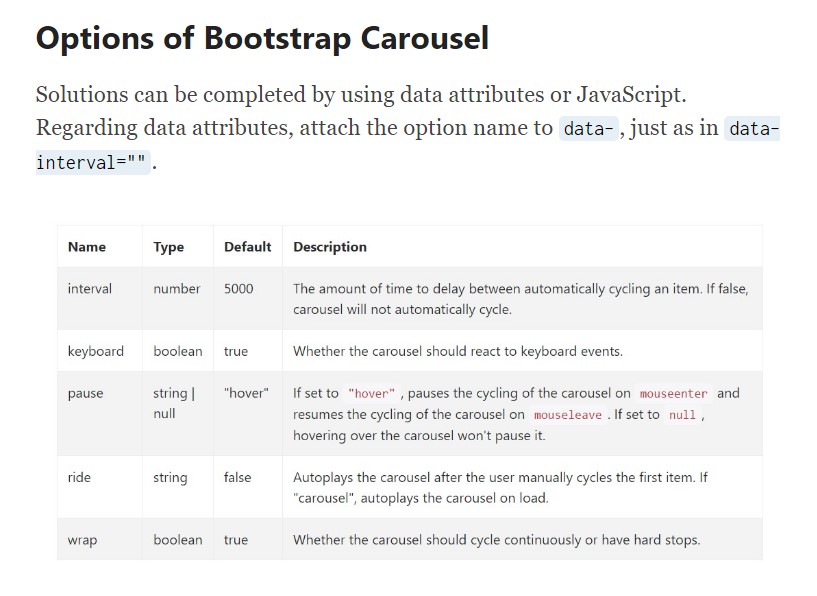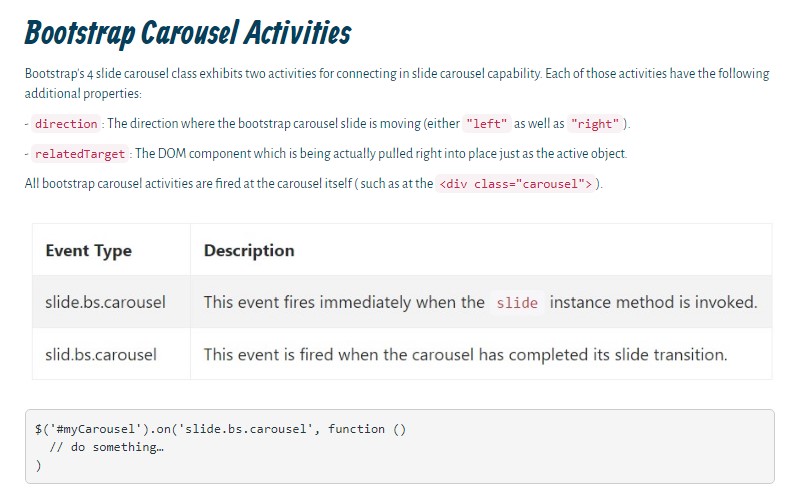Bootstrap Carousel Mobile
Intro
Who exactly does not appreciate shifting images including a number of cool captions and text message clarifying what exactly they show, more effective carrying the message or even why not actually much better-- as well providing a number of switches as well calling the visitor to have some action at the very start of the page because all of these are commonly placed in the beginning. This stuff has been really dealt with in the Bootstrap system through the installed carousel component that is totally supported and pretty convenient to receive together with a plain and clean structure.
The Bootstrap Carousel Slide is a slide show for cycling within a set of material, established with CSS 3D transforms and a piece of JavaScript. It works with a series of images, message, as well as custom markup. It additionally incorporates support for previous/next controls and signs.
Exactly how to work with the Bootstrap Carousel Responsive:
All you need is a wrapper component along with an ID to provide the entire carousel element possessing the
.carousel.slidedata-ride="carousel"carousel-inner.carousel-innerExample
Carousels really don't systematically change slide sizes. Because of this, you may possibly will need to put into action extra functions or maybe custom made styles to properly scale material. Although carousels promote previous/next regulations and signs, they are actually not explicitly needed. Custom and include considering that you see fit.
Don't forget to set up a special id on the
.carouselOnly just slides
Here is a Bootstrap Carousel Effect along with slides only . Keep in mind the exposure of the
.d-block.img-fluid<div id="carouselExampleSlidesOnly" class="carousel slide" data-ride="carousel">
<div class="carousel-inner" role="listbox">
<div class="carousel-item active">
<div class="img"><img class="d-block img-fluid" src="..." alt="First slide"></div>
</div>
<div class="carousel-item">
<div class="img"><img class="d-block img-fluid" src="..." alt="Second slide"></div>
</div>
<div class="carousel-item">
<div class="img"><img class="d-block img-fluid" src="..." alt="Third slide"></div>
</div>
</div>
</div>Additionally
You can certainly also set up the time each slide becomes displayed on web page via adding a
data-interval=" ~ number in milliseconds ~". carouselSlideshow plus controls
The site navigation around the slides gets performed via specifying two link elements with the class
.carousel-control.left.rightrole=" button"data-slide="prev"nextThis so far goes to ensure the commands will work the proper way but to also ensure the site visitor realises these are certainly there and realises what exactly they are performing. It additionally is a really good idea to place a number of
<span>.icon-prev.icon-next.sr-onlyNow for the main factor-- positioning the concrete pictures which should materialize within the slider. Every pic element ought to be wrapped within a
.carousel-item.item classIncluding in the next and previous commands:

<div id="carouselExampleControls" class="carousel slide" data-ride="carousel">
<div class="carousel-inner" role="listbox">
<div class="carousel-item active">
<div class="img"><img class="d-block img-fluid" src="..." alt="First slide"></div>
</div>
<div class="carousel-item">
<div class="img"><img class="d-block img-fluid" src="..." alt="Second slide"></div>
</div>
<div class="carousel-item">
<div class="img"><img class="d-block img-fluid" src="..." alt="Third slide"></div>
</div>
</div>
<a class="carousel-control-prev" href="#carouselExampleControls" role="button" data-slide="prev">
<span class="carousel-control-prev-icon" aria-hidden="true"></span>
<span class="sr-only">Previous</span>
</a>
<a class="carousel-control-next" href="#carouselExampleControls" role="button" data-slide="next">
<span class="carousel-control-next-icon" aria-hidden="true"></span>
<span class="sr-only">Next</span>
</a>
</div>Making use of hints
You can easily additionally incorporate the indications to the slide carousel, alongside the controls, too
In the primary
.carousel.carousel-indicatorsdata-target="#YourCarousel-ID" data-slide-to=" ~ appropriate slide number ~"
<div id="carouselExampleIndicators" class="carousel slide" data-ride="carousel">
<ol class="carousel-indicators">
<li data-target="#carouselExampleIndicators" data-slide-to="0" class="active"></li>
<li data-target="#carouselExampleIndicators" data-slide-to="1"></li>
<li data-target="#carouselExampleIndicators" data-slide-to="2"></li>
</ol>
<div class="carousel-inner" role="listbox">
<div class="carousel-item active">
<div class="img"><img class="d-block img-fluid" src="..." alt="First slide"></div>
</div>
<div class="carousel-item">
<div class="img"><img class="d-block img-fluid" src="..." alt="Second slide"></div>
</div>
<div class="carousel-item">
<div class="img"><img class="d-block img-fluid" src="..." alt="Third slide"></div>
</div>
</div>
<a class="carousel-control-prev" href="#carouselExampleIndicators" role="button" data-slide="prev">
<span class="carousel-control-prev-icon" aria-hidden="true"></span>
<span class="sr-only">Previous</span>
</a>
<a class="carousel-control-next" href="#carouselExampleIndicators" role="button" data-slide="next">
<span class="carousel-control-next-icon" aria-hidden="true"></span>
<span class="sr-only">Next</span>
</a>
</div>Provide several underlines as well.
Put in captions to your slides quickly with the .carousel-caption feature in any .carousel-item.
To include several captions, specification plus switches to the slide bring in an additional
.carousel-captionThey can surely be conveniently hidden on compact viewports, as demonstrated below, utilizing alternative display screen utilities. We conceal all of them primarily by using
.d-none.d-md-block
<div class="carousel-item">
<div class="img"><img src="..." alt="..."></div>
<div class="carousel-caption d-none d-md-block">
<h3>...</h3>
<p>...</p>
</div>
</div>A bit more tips
A beautiful method is when ever you really want a hyperlink or possibly a switch on your webpage to lead to the slide carousel on the other hand also a special slide in it as being detectable at the moment. You can certainly do this with assigning
onclick=" $(' #YourCarousel-ID'). carousel( ~ the needed slide number );"Treatment
Using data attributes
Make use of data attributes to easily deal with the placement of the slide carousel
.data-slideprevnextdata-slide-todata-slide-to="2"The
data-ride="carousel"Using JavaScript
Call slide carousel manually by having:
$('.carousel').carousel()Opportunities
Selections can possibly be passed by means of data attributes or JavaScript. To data attributes, add the option title to
data-data-interval=""
Practices
.carousel(options)
.carousel(options)Initializes the slide carousel having an optional opportunities
object$('.carousel').carousel(
interval: 2000
).carousel('cycle')
.carousel('cycle')Cycles through the carousel items coming from left to right.
.carousel('pause')
.carousel('pause')Blocks the carousel from cycling through things.
.carousel(number)
.carousel(number)Moves the slide carousel to a certain frame (0 based, similar to an array)..
.carousel('prev')
.carousel('prev')Moves to the previous object.
.carousel('next')
.carousel('next')Cycles to the next element.
Activities
Bootstrap's slide carousel class reveals two activities for hooking into carousel useful functionality. Each of the occasions have the following added properties:
direction"left""right"relatedTargetEvery one of slide carousel events are ejected at the carousel in itself such as at the
<div class="carousel">
$('#myCarousel').on('slide.bs.carousel', function ()
// do something…
)Final thoughts
So actually this is the solution the slide carousel component is designed in the Bootstrap 4 framework. It is actually really elementary as well as direct . However it is fairly an attractive and handy way of feature a lot of web content in a lot less area the slide carousel component really should however be used cautiously considering the clarity of { the text message and the site visitor's comfort.
Too much images might be missed out to get viewed with scrolling downward the web page and in case they slide very speedily it might end up being very difficult certainly noticing all of them as well as review the messages which in turn could sooner or later misinform as well as anger the webpage visitors or an significant appeal to activity might be skipped-- we definitely don't want this stuff to happen.
Check out a couple of online video training about Bootstrap Carousel:
Connected topics:
Bootstrap Carousel formal records

Mobirise Bootstrap Carousel & Slider

Bootstrap 4 Сarousel issue

jQuery Bootstrap Carousel Template
CSS Bootstrap 4 Carousel Slider





